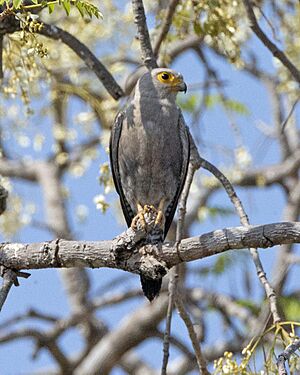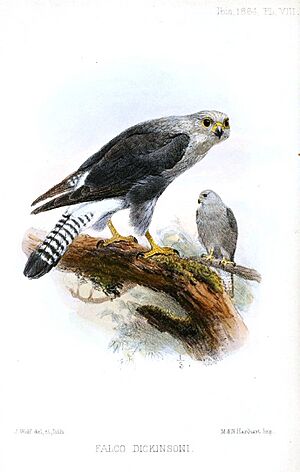Dickinson's kestrel facts for kids
Quick facts for kids Dickinson's kestrel |
|
|---|---|
 |
|
| in Liwonde, Malawi | |
| Conservation status | |
| Scientific classification | |
| Genus: |
Falco
|
| Species: |
dickinsoni
|
The Dickinson's kestrel (scientific name: Falco dickinsoni) is a cool bird of prey found in southern and eastern Africa. It belongs to the falcon family, called Falconidae. This bird got its name from John Dickinson, an English doctor and missionary. He was the first person to collect a sample of this bird for science. People also call it the white-rumped kestrel because of its pale rear. It is closely related to the grey kestrel and banded kestrel.
What Does Dickinson's Kestrel Look Like?

This kestrel is a fairly small, strong bird. It has a big, square-shaped head. It measures about 27 to 30 centimeters (10.5 to 12 inches) long. Its wings can spread out to 61 to 68 centimeters (24 to 27 inches). It weighs between 167 and 246 grams (about 6 to 8.5 ounces). Female kestrels are a bit bigger and heavier than males.
Most of its feathers are dark grey. However, its head and the area above its tail (rump) are much paler. The tail is grey with thin black stripes. It also has a wide black band near the end. The feathers under its wings also have stripes. The skin around its beak (cere) and its feet are yellow. There is also bare yellow skin around its eyes. Its beak is dark grey, and its eyes are brown.
Young kestrels look a bit different. They are grey-brown with stripes on their sides. They do not have the paler head and rump like the adults. Their cere and eye-ring are greenish.
Dickinson's kestrels are usually quiet birds. But they do make a high-pitched alarm call if they sense danger. They also use a contact call to talk to each other. When they are at the nest, they make a soft, mewing sound. This sound helps to attract their young for feeding time.
Where Do Dickinson's Kestrels Live?
This kestrel lives in savanna areas and open woodland. They especially like swampy places close to water. They prefer areas with miombo woodland. You can often find them near palm trees, like Hyphaene and Borassus types. They are also often seen near baobab trees. In some places, they even live in coconut plantations.
Their home range covers a large part of southern and eastern Africa. This includes most of Mozambique, Zimbabwe, Zambia, and Malawi. They are also found in north-eastern South Africa, especially in Kruger National Park. You can see them in northern Botswana, north-east Namibia, eastern Angola, and southern Democratic Republic of the Congo. They also live in parts of Tanzania. Sometimes, they visit Kenya.
The total area where they live is huge, about 3.4 million square kilometers (1.3 million square miles). They are generally not very common. However, they are more common in some places, like Zanzibar and Pemba Islands. Losing palm trees is a possible threat to these birds. This is because palm trees are an important part of their habitat.
How Do Dickinson's Kestrels Behave?
Dickinson's kestrels usually hunt from a high spot, like a tree branch. They only hover in the air sometimes. Their diet mainly consists of large insects, such as grasshoppers. They also eat lizards and amphibians. Sometimes, they will catch birds, bats, rodents, and even snakes. They are often drawn to grass fires. This is because they can easily catch insects and other small animals trying to escape the flames.
The breeding season for these kestrels varies by location. In Tanzania, it lasts from July to October. Further south, it is from September to December. They build a very simple nest. It is just a shallow dip with no extra materials. They usually place their nest 2 to 18 meters (6.5 to 59 feet) above the ground. They often choose the top of a dead palm tree or a hole in a baobab tree. Sometimes, they even use an old nest built by a Hamerkop bird.
A female kestrel lays one to four eggs. The eggs are cream-colored with reddish-brown marks. The female sits on the eggs to keep them warm for at least 30 days. This process is called incubation. The young birds are ready to fly after about 33 to 35 days.


